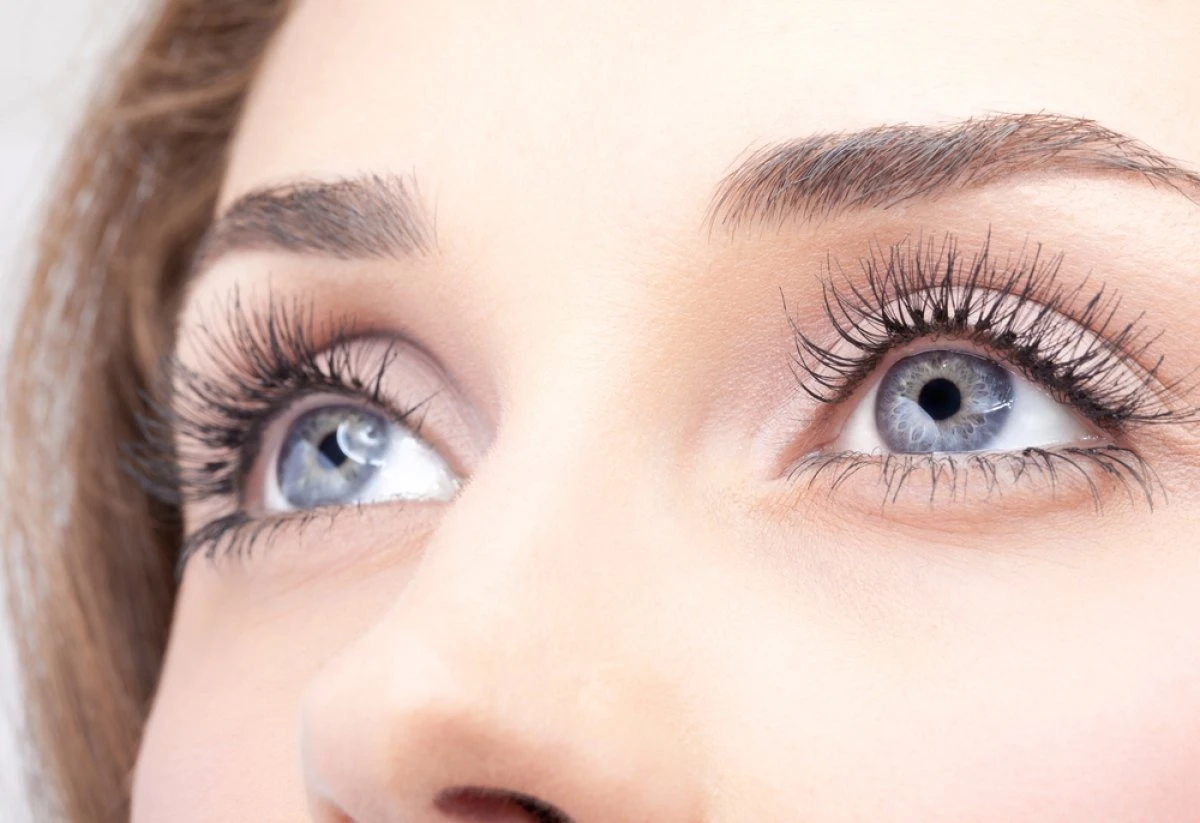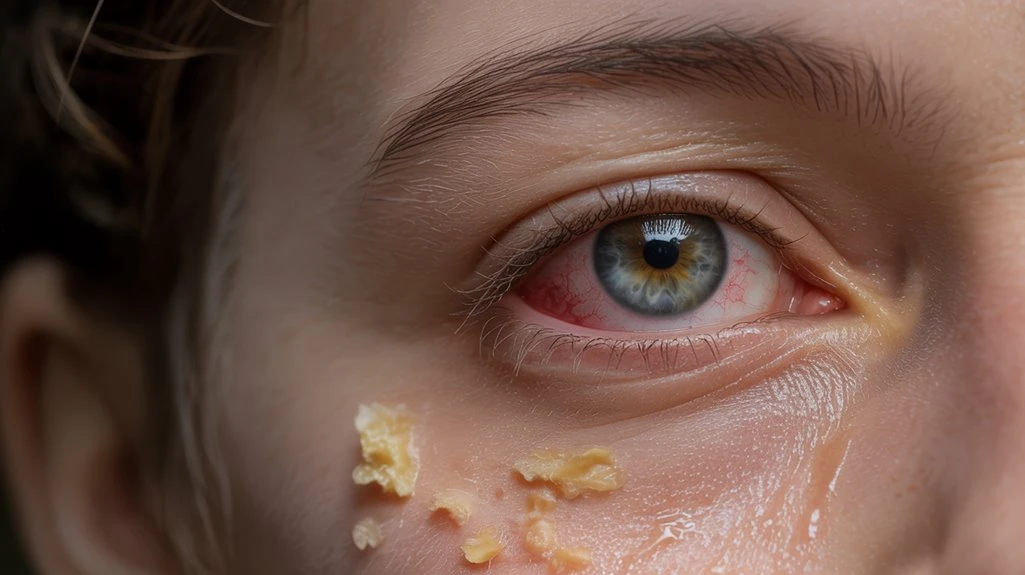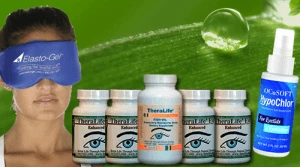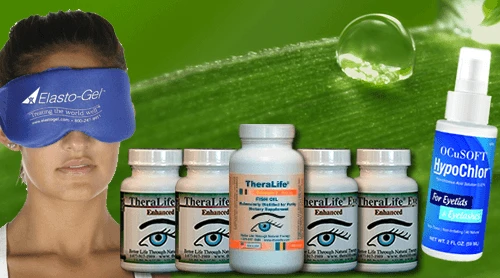If your eyes are red and crusty, it could be due to irritation or infection, commonly caused by conditions such as conjunctivitis, blepharitis, allergies, or dry eye syndrome. TheraLife offers a unique solution to these issues as the only company providing oral eye treatment care. Their products are designed to tackle the root causes of eye discomfort, offering relief from symptoms like redness, discharge, and crusting. TheraLife’s approach includes a range of supplements that focus on reducing inflammation, improving eye lubrication, and promoting overall eye health. Accurate diagnosis is crucial since treatments can vary from antibiotics to hygiene measures and lubricants. TheraLife’s products offer a comprehensive and natural solution to eye health, making them a valuable option for many suffering from these conditions. For more details on how TheraLife’s products can benefit you, visit their website.
Best Oral Crusty Eyes Treatment from TheraLife
Add To Cart
Key Takeaways
- Red and crusty eyes are commonly caused by infections like conjunctivitis or blepharitis, which lead to inflammation and discharge.
- Allergic reactions to pollen, dust, or irritants can trigger redness and crusting around the eyes.
- Dry Eye Syndrome can result in redness, irritation, and crusty debris due to poor tear production.
- Poor contact lens hygiene increases the risk of eye infections, causing redness and crusting.
- Persistent or severe symptoms may indicate a more serious condition and require prompt medical attention.
Common Causes of Red and Crusty Eyes
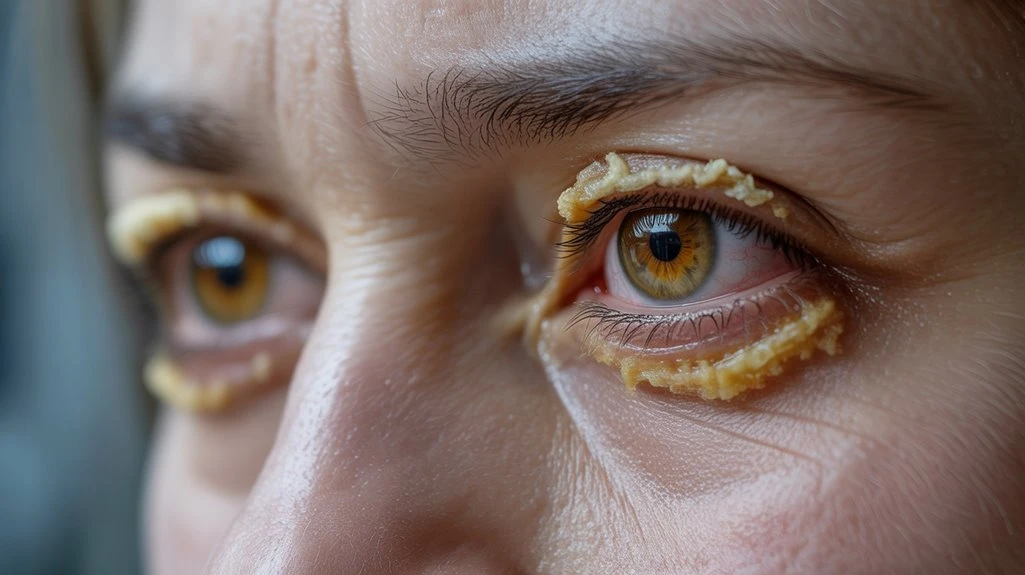
When evaluating red and crusty eyes, clinicians primarily consider infectious conjunctivitis, blepharitis, and allergic reactions as leading etiologies.
Infectious conjunctivitis, whether viral or bacterial, typically presents with conjunctival injection, mucopurulent discharge, and eyelid crusting upon waking.
Blepharitis, an inflammation of the eyelid margins, often results in chronic redness, debris at the lash line, and intermittent irritation.
You should also recognize that allergic reactions—triggered by environmental factors such as pollen, dust mites, or pet dander—can produce significant conjunctival hyperemia and watery discharge, accompanied by eyelid swelling and pruritus.
Each condition has distinguishing features, but symptom overlap is common, warranting a thorough history and slit-lamp examination.
Identifying the primary etiology guarantees targeted therapy and symptom resolution, reducing the risk of chronic ocular surface disease.
Allergies and Their Impact on Eye Health
Although ocular allergies frequently present with mild symptoms, they can considerably disrupt the ocular surface and periocular tissues. When you’re exposed to environmental allergens—most commonly pollen exposure during seasonal allergies—immune-mediated inflammation can develop. This response often manifests as conjunctival hyperemia, chemosis, and lid edema. You’ll likely notice pruritus, tearing, and a stringy mucoid discharge, which contribute to the red and crusty appearance of your eyes. Blocked Tear Ducts can also lead to constant watery eyes and may exacerbate the symptoms of ocular allergies. Diagnostic evaluation typically involves identifying a history of allergy triggers and correlating symptom onset with high pollen counts or other allergens. Slit-lamp examination may reveal papillary conjunctival changes and increased lacrimal secretions. Proper differentiation from other etiologies is essential, ensuring that focused management strategies—such as allergen avoidance and topical antihistamines—are implemented to reduce recurrence and improve ocular surface integrity.
The Role of Conjunctivitis in Eye Irritation
Conjunctivitis, a common cause of ocular discomfort, frequently leads to pronounced redness and crusting of the eyes due to inflammation of the conjunctival membrane. You’ll notice conjunctivitis symptoms such as hyperemia, increased lacrimation, mucopurulent discharge, and eyelid edema. These clinical findings may result from viral, bacterial, or allergic etiologies, making differential diagnosis essential. Accurate identification relies on history, slit-lamp examination, and, when indicated, microbiological testing. Early recognition of conjunctivitis symptoms enables timely intervention, reducing the risk of transmission and complications. Conjunctivitis treatment varies according to etiology: bacterial cases typically require topical antibiotics, while viral forms are managed supportively. Allergic conjunctivitis responds well to antihistamines or mast cell stabilizers. Prompt diagnosis and evidence-based conjunctivitis treatment are critical for restoring ocular surface health and minimizing patient discomfort. Subconjunctival Hemorrhage is another condition that can cause red eyes, characterized by painless red spots on the sclera due to ruptured blood vessels, often resolving on its own.
Blepharitis: Inflammation of the Eyelids
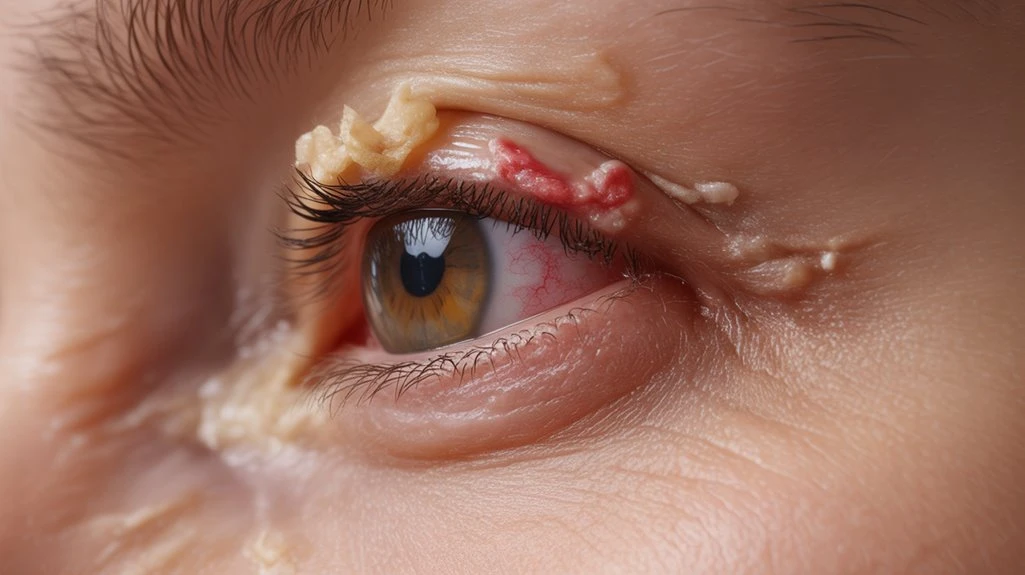
If you observe persistent eyelid redness, irritation, and debris at the lash margin, consider blepharitis as a leading diagnosis. This chronic inflammatory condition primarily affects the eyelid margins and is commonly associated with bacterial colonization or seborrheic dermatitis. Diagnostic features include collarettes, eyelid margin thickening, and telangiectasia. Without appropriate eyelid hygiene, symptoms often recur and may worsen. Treatment options focus on mechanical removal of debris and reducing microbial load. Warm compresses followed by gentle lid scrubs are first-line interventions. In refractory cases, topical or oral antibiotics may be indicated. Regular eyelid hygiene can control symptoms and prevent flare-ups. The following table summarizes diagnostic clues versus recommended management:
| Diagnostic Clue | Recommended Management |
|---|---|
| Collarettes at lashes | Lid scrubs, warm compress |
| Chronic redness | Improved eyelid hygiene |
| Crusting/debris | Topical antibiotics |
| Eyelid swelling | Oral antibiotics if severe |
| Telangiectasia | Long-term hygiene measures |
Dry Eye Syndrome and Its Symptoms
Red, irritated eyes aren’t always caused by infection or eyelid inflammation; Dry Eye Syndrome is another frequent culprit, especially when patients report persistent grittiness, burning, and fluctuating vision.
If you experience these symptoms, it’s likely your eyes aren’t receiving adequate lubrication due to insufficient or poor-quality tear production. Clinically, Dry Eye Syndrome arises when either the quantity or stability of your tears is compromised, disrupting the ocular surface and leading to redness and a crusty appearance.
You may also notice light sensitivity, excessive tearing (as a reflex response), or discomfort with prolonged visual tasks.
Proper balance of all three layers of the tear film is crucial to prevent dry eye, as this balance ensures adequate hydration, prevents evaporation, and distributes tears evenly across the eye surface.
Diagnostic evaluation includes tear film assessment, ocular surface staining, and measuring tear breakup time.
Addressing underlying tear production issues and optimizing eye lubrication are central to managing this condition and alleviating your symptoms.
Eye Infections You Should Know About
Although many causes of red, crusty eyes stem from non-infectious sources, a range of eye infections can produce similar symptoms and warrant prompt recognition.
Viral infections, such as adenoviral conjunctivitis, frequently present with acute redness, watery discharge, and eyelid crusting. You’re more likely to experience bilateral involvement with viral etiologies.
In contrast, bacterial infections—most commonly caused by Staphylococcus aureus or Streptococcus pneumoniae—typically induce purulent discharge, pronounced eyelid edema, and conjunctival hyperemia. These findings help differentiate bacterial from viral conjunctivitis.
You should also consider blepharitis, which involves inflammation of the eyelid margins and often results from bacterial colonization, producing crusty debris at the lash line.
Accurate identification of the underlying pathogen is critical, as management strategies and the need for antimicrobial therapy differ between viral and bacterial infections.
In addition, eyelash mites can lead to blepharitis, which is characterized by eyelid irritation and inflammation, and might also contribute to red and crusty eyes.
Contact Lens Issues and Eye Discomfort
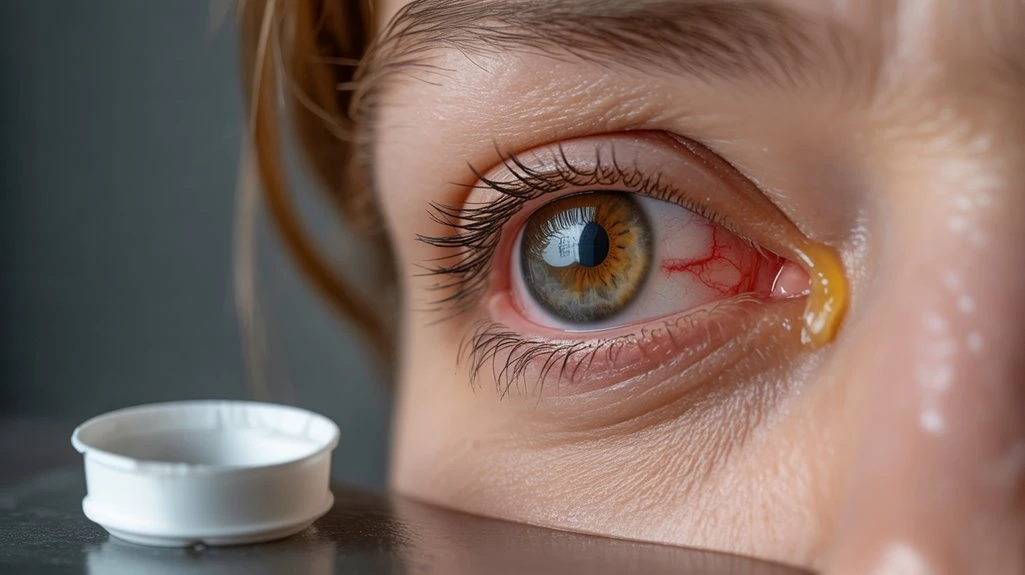
If you wear contact lenses, improper hygiene or extended wear often leads to ocular surface irritation, redness, and discharge. Clinical evidence shows that poor cleaning practices and overwearing increase your risk for microbial keratitis and conjunctivitis. You may also experience allergic responses to lens materials or solutions, manifesting as redness and periocular crusting. It is important to recognize that conditions such as chronic dry eyes can exacerbate these issues, leading to further discomfort and complications.
Improper Lens Hygiene
Improper contact lens hygiene frequently leads to ocular surface irritation, manifesting as redness, discomfort, and crusting of the eyelids or lashes. When you neglect recommended lens care protocols, microbial contamination and buildup of protein deposits can occur. Poor hygiene practices, such as failing to wash your hands before handling lenses or using expired cleaning solutions, increase your risk for conjunctivitis and blepharitis. These inflammatory conditions not only cause visible redness and crusting but also compromise tear film stability, exacerbating ocular discomfort. Diagnostic evaluation often reveals papillary conjunctival changes and debris on the lid margin. Inadequate lens care resulting in microbial contamination. Skipping recommended daily cleaning and disinfection. Topping off or reusing old contact lens solutions. Handling lenses with unwashed hands, increasing infection risk. Additionally, eyelid swelling can be caused by serious medical conditions that require immediate attention.
Extended Wear Problems
While contact lenses offer significant convenience, extended wear increases your risk for ocular surface complications, such as redness and periocular crusting.
Prolonged use of contact lenses reduces oxygen transmission to the corneal epithelium, heightening the risk for hypoxic stress. This environment can compromise the tear film, leading to dryness, irritation, and accumulation of ocular discharge. Such discharge often dries along the eyelid margins, causing the characteristic “crusty” appearance.
You may also notice increased conjunctival hyperemia, a clinical sign of inflammation due to chronic lens wear.
Extended wear predisposes you to microtrauma and disrupts natural ocular defenses, making you more susceptible to microbial colonization. If you experience persistent redness, discomfort, or periocular crusting during extended wear, prompt evaluation is essential to rule out complications or infection.
Addressing underlying conditions such as Dry Eye and conjunctivitis can help reduce these symptoms and prevent further complications.
Allergic Reactions Occur
Although contact lenses are designed to be biocompatible, allergic reactions can still develop and manifest as ocular redness, itching, and periocular crusting.
If you use contact lenses, you’re at risk for hypersensitivity responses when allergens such as pollen exposure occur, especially during seasonal allergies. These reactions may be due to protein deposits on the lens surface or inadequate lens hygiene, exacerbating discomfort and inflammation.
- Sudden onset of conjunctival hyperemia after outdoor activities
- Increased mucous production and eyelid margin crusting
- Persistent ocular pruritus unrelieved by lens removal
- History of seasonal allergies intensifying contact lens intolerance
Diagnostic evaluation should focus on differentiating allergic conjunctivitis from infectious etiologies.
Management involves discontinuation of lens wear, initiation of preservative-free lubricants, and addressing environmental allergens.
Consider allergen avoidance strategies for ideal ocular surface health. A focus on anti-inflammatory foods can also aid in reducing inflammation, as highlighted in the management of autoimmune conditions like Sjögren’s syndrome.
When Redness Signals Something More Serious
If you notice persistent redness, pain, photophobia, or purulent discharge, you might be experiencing signs of an ocular infection.
Evidence suggests these symptoms can indicate conditions like bacterial conjunctivitis or even keratitis, which require prompt evaluation.
Don’t hesitate to seek medical attention if symptoms worsen or fail to improve, as early intervention is critical for preventing complications.
Signs of Eye Infection
Anyone experiencing persistent eye redness and crusting should recognize these as potential signs of an underlying eye infection.
While mild irritation might be related to poor eye hygiene or the presence of foreign particles, true infection often presents with additional clinical indicators.
Prompt identification is vital, as untreated infections can compromise ocular health and vision.
Look for these key signs that suggest your symptoms are more than simple irritation:
- Continuous, thick, or yellow-green discharge that causes lids to stick together
- Intense redness in the white of the eye, often spreading beyond a localized area
- Swelling and tenderness of the eyelids or surrounding tissues
- Persistent itching, burning, or a gritty sensation that doesn’t improve with basic care
When to Seek Help
Sometimes, persistent eye redness and crusting signal a condition that requires urgent medical evaluation. If redness triggers severe pain, vision changes, light sensitivity, or copious discharge, these are urgent symptoms that shouldn’t be ignored.
You should also seek help if redness persists beyond a few days or if it’s accompanied by swelling, fever, or trauma. These clinical signs may indicate underlying pathologies such as bacterial keratitis, uveitis, or acute glaucoma, all of which need prompt diagnosis and intervention to prevent complications or vision loss.
If over-the-counter remedies fail to improve symptoms, or if you experience recurrent episodes, consult an eye care professional. Timely recognition and management of these urgent symptoms is essential for protecting ocular health and maintaining visual function.
Best Oral Crusty Eyes Treatment from TheraLife
Add To Cart
Home Remedies and Self-Care Tips
While mild redness and crusting of the eyes often result from common irritants or viral conjunctivitis, targeted self-care measures can alleviate discomfort and support recovery.
Employing evidence-based home remedies is essential in managing symptoms and preventing further irritation. First, maintain rigorous hand hygiene to reduce the risk of pathogen transmission.
Apply a sterile, cool compress to your closed eyelids to decrease inflammation and remove crusting. Artificial tears, available over the counter, help maintain ocular surface lubrication and flush out allergens.
Avoid contact lens use and refrain from eye makeup until symptoms resolve, minimizing exposure to potential irritants.
- Wash hands thoroughly before touching your eyes
- Use a clean, damp cloth to gently remove eye discharge
- Instill preservative-free artificial tears as needed
- Discontinue contact lenses and cosmetic products temporarily
When to Seek Medical Attention
Persistent or worsening eye redness and crusting, despite appropriate self-care, may indicate a more serious underlying condition requiring medical evaluation.
If you experience severe pain, vision changes, photophobia, or copious discharge, you should promptly consult an ophthalmologist. These symptoms could be signs of infectious conjunctivitis, keratitis, uveitis, or other ocular pathologies needing specific diagnosis options.
Healthcare providers may use slit-lamp examination, fluorescein staining, or microbial cultures to determine the etiology. Accurate diagnosis guides treatment possibilities, which could include topical or systemic antibiotics, antiviral agents, corticosteroids, or lubricating drops, depending on the underlying cause.
Delaying care can increase the risk of complications, including vision loss. Early intervention guarantees the most effective management and preserves ocular health.
Seek expert evaluation when in doubt.
Best Oral Crusty Eyes Treatment from TheraLife
Add To Cart
Frequently Asked Questions
Can Diet or Nutrition Affect Eye Redness and Crustiness?
You should consider how nutrient deficiencies and hydration levels impact ocular surface health.
Deficiencies in vitamin A, omega-3 fatty acids, or zinc can compromise tear film stability, leading to conjunctival irritation and increased risk of eye redness and crustiness.
Inadequate hydration reduces tear production, exacerbating dryness and inflammation.
Clinical evidence supports evaluating your dietary intake and fluid consumption as part of a diagnostic approach to persistent ocular surface symptoms like redness and crusting.
Are Certain Climates More Likely to Cause Red, Crusty Eyes?
Studies show that up to 30% of people living in low humidity environments report ocular surface discomfort.
You’ll notice that climates with low humidity levels and significant temperature fluctuations can compromise tear film stability, increasing your risk for conjunctival redness and periocular crusting.
Chronic exposure to dry, windy, or excessively hot or cold conditions exacerbates evaporative tear loss, leading to more frequent presentations of these symptoms in clinical practice.
Consider environmental management as part of your diagnostic approach.
Do Pets Increase the Risk of Developing These Eye Symptoms?
If you have pets, you might increase your risk of developing eye symptoms due to pet allergies.
Animal dander acts as a common allergen, triggering conjunctival inflammation, hyperemia, and mucous discharge.
If you notice persistent redness, pruritus, or crusting, consider exposure history and evaluate for allergic conjunctivitis.
Diagnostic confirmation often involves skin prick testing or serum IgE levels.
Managing pet exposure and antihistamine therapy can alleviate these symptoms effectively.
Can Screen Time Worsen Red and Crusty Eyes?
Excessive screen time exposes your eyes to blue light, which research links to increased eye strain and decreased blink rates.
This can compromise tear film stability, leading to ocular surface dryness and irritation.
Clinical evidence suggests that prolonged digital device use exacerbates symptoms like redness and crusting, particularly if you’re predisposed to dry eye syndrome.
To mitigate these effects, ophthalmologists recommend regular breaks and optimizing screen ergonomics to reduce blue light exposure.
Are Children More Susceptible Than Adults to These Symptoms?
You might think adults have weaker eyes, but children are actually more susceptible to red and crusty symptoms.
Their child immune system isn’t fully developed, making them more prone to infections and inflammatory responses. Increased environmental exposure—like touching their faces or crowded settings—further elevates risk.
Evidence-based studies confirm that diagnostic rates of conjunctivitis and allergic reactions are higher in pediatric populations, so you should monitor your child’s ocular health closely.
Best Oral Crusty Eyes Treatment from TheraLife
Add To Cart
Conclusion
If your eyes are red and crusty, addressing the issue promptly is crucial to maintaining your ocular health. While allergies, conjunctivitis, blepharitis, and dry eye are common causes, sometimes redness indicates a more serious condition. TheraLife stands out as the only company offering oral eye treatment care specifically designed to tackle these issues. Their products focus on providing targeted relief and promoting overall eye health naturally. By incorporating TheraLife’s evidence-based products into your self-care routine, you can effectively manage symptoms and prevent complications. However, if symptoms persist or worsen, it is advisable to consult a healthcare professional for a precise diagnosis and targeted treatment. Your vigilance today, coupled with TheraLife’s unique offerings, can safeguard your ocular health for the future.

